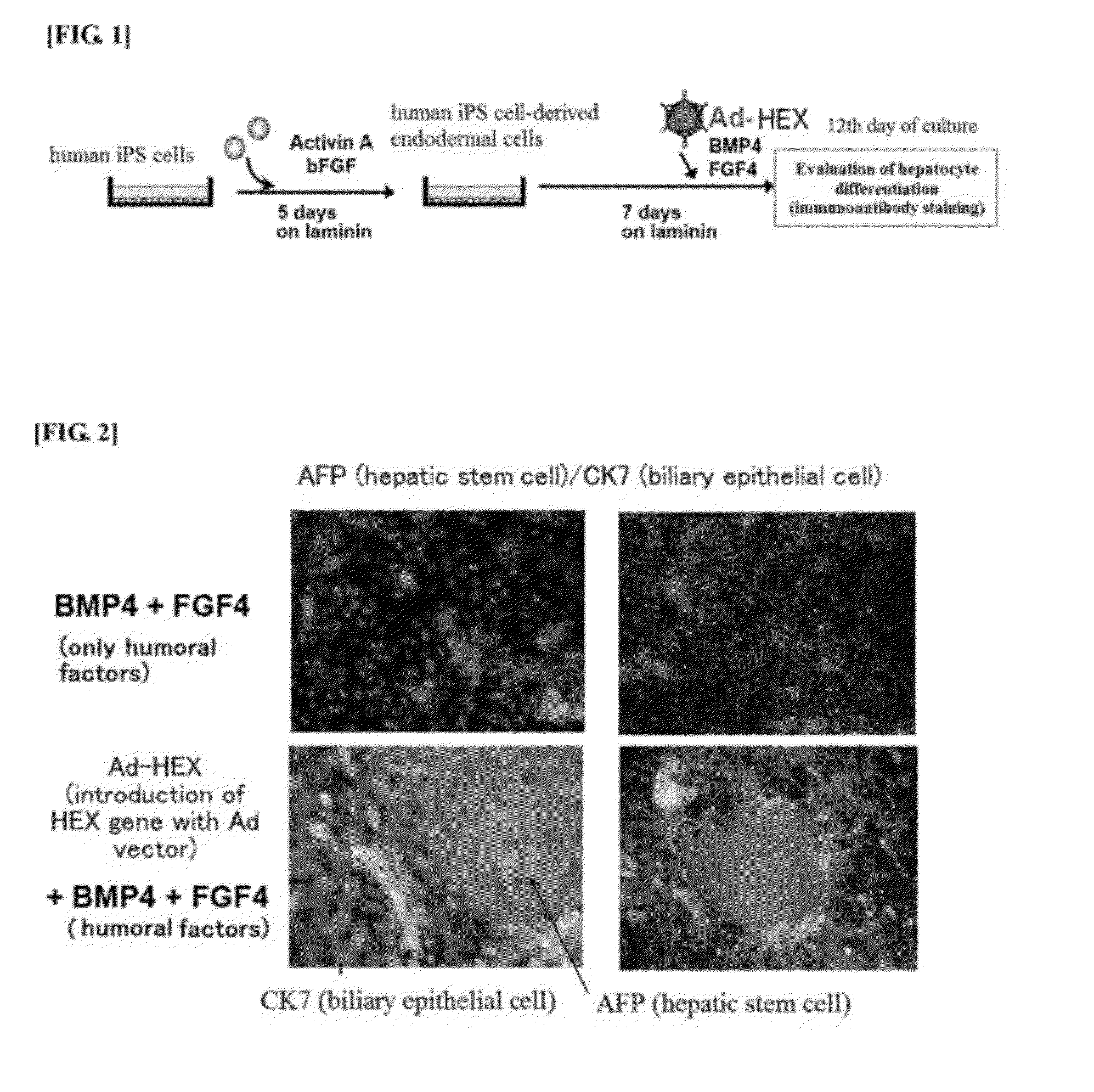Method Of Differentiation From Stem Cells To Hepatocytes
a technology of stem cells and hepatocytes, applied in the field of stem cell differentiation from pluripotent stem cells, can solve the problems of not disclosing the method of differentiation, and achieve the effects of promoting differentiation, promoting differentiation, and promoting differentiation
- Summary
- Abstract
- Description
- Claims
- Application Information
AI Technical Summary
Benefits of technology
Problems solved by technology
Method used
Image
Examples
example 1
Method of Inducing Differentiation from Human iPS Cells to Hepatocytes
[0099]In this Example, induction of differentiation from human iPS cells containing the HEX gene introduced by using Ad vector to hepatocytes will be described. The experimental scheme in this Example is shown in FIG. 1.
[0100]1) Construction of Ad Vector for Introduction of HEX Gene
[0101]An Ad vector having a gene introduced into the E1-deficient region of a E1-deficient type-5 Ad genome (pAdHM41-K7) and an EF-1α promoter in the region upstream thereof was prepared. The gene introduced was the HEX gene having the sequence of GenBank Accession No. BG014336.
[0102]2) Culture of Human iPS Cells
[0103]Human iPS cells (Tic (JCRB1331), Dotcom (JCRB1327), and Squeaky (JCRB1329)) were used in this Example. Cultured human iPS cells were obtained by using mouse fetal fibroblasts (MEF) as feeder cells and the medium 1 shown in Reference Example according to the method described in Tiss. Cult. Res. Commun., 27:139-147 (2008). T...
example 2
Method of Differentiation from Human ES Cells to Hepatocytes
[0112]In this Example, HEX gene was introduced by using an Ad vector into the human ES cells (KhES-1) established by the Inst. for Frontier Medical Science, Kyoto Univ., replacing the human iPS cells above, and induction of differentiation from human ES cells to hepatocytes was studied. In this Example, 1) an Ad vector for introduction of HEX gene was constructed, 3) the HEX gene was introduced into human ES cells, and the test was performed in a manner similar to Example 1, except that the cultured human ES cells were prepared by using mouse fetal fibroblasts (MEF) as the feeder cells and the medium 2 shown in Reference Example according to the method described in Tiss. Cult, Res. Commun., 27: 139-147 (2008).
example 3
Method of Differentiation from Human iPS Cells to Hepatocytes
[0115]In this Example, induction of differentiation from human iPS cells containing the HEX gene introduced by using an Ad vector to hepatocytes will be described. The experimental scheme in this Example is shown in FIG. 1. 1) Construction of an Ad vector for introduction of HEX gene, 2) culture of human iPS cells and 3) introduction of HEX gene into human iPS cells were carried out in a manner similar to Example 1. Human iPS cells (Squeaky (JCRB 1329)) were used.
PUM
| Property | Measurement | Unit |
|---|---|---|
| Time | aaaaa | aaaaa |
| Time | aaaaa | aaaaa |
| Time | aaaaa | aaaaa |
Abstract
Description
Claims
Application Information
 Login to View More
Login to View More - R&D
- Intellectual Property
- Life Sciences
- Materials
- Tech Scout
- Unparalleled Data Quality
- Higher Quality Content
- 60% Fewer Hallucinations
Browse by: Latest US Patents, China's latest patents, Technical Efficacy Thesaurus, Application Domain, Technology Topic, Popular Technical Reports.
© 2025 PatSnap. All rights reserved.Legal|Privacy policy|Modern Slavery Act Transparency Statement|Sitemap|About US| Contact US: help@patsnap.com



